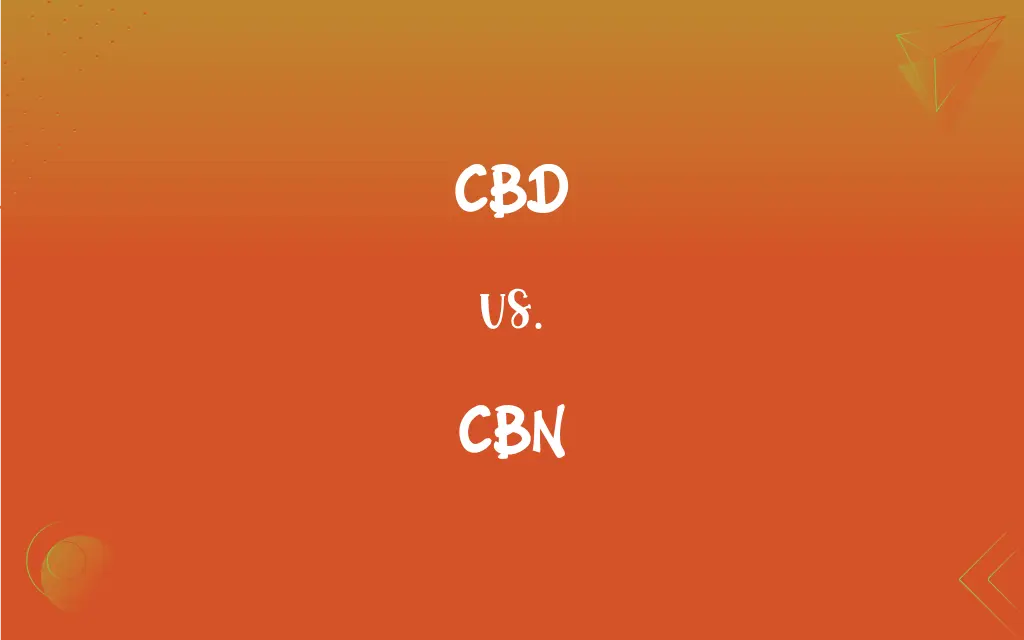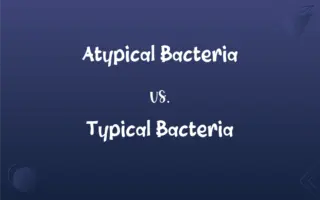CBD vs. CBN: What's the Difference?
Edited by Aimie Carlson || By Harlon Moss || Updated on October 27, 2023
CBD is a non-intoxicating cannabinoid from cannabis plants known for potential therapeutic benefits; CBN is a mildly psychoactive cannabinoid resulting from THC degradation.

Key Differences
CBD, or cannabidiol, is one of the primary cannabinoids found in cannabis and hemp plants, renowned for its potential therapeutic applications without producing a "high." CBN, or cannabinol, while also found in the cannabis plant, is typically present in minimal amounts and is known for being mildly psychoactive.
CBD has been researched for potential health benefits such as pain relief, anti-inflammation, and anxiety reduction. CBN, though lesser-known, is often associated with sedative effects, although research on this is limited.
In the lifecycle of the cannabis plant, CBD is directly derived from the hemp plant, a member of the cannabis plant family. CBN, on the other hand, is produced when THC (tetrahydrocannabinol) ages and is exposed to oxygen over time.
Both CBD and CBN can be extracted and isolated for various product formulations. CBD is more commonly found in products such as oils, edibles, and topicals due to its broader therapeutic potential. CBN, though less common, is starting to gain attention in products formulated for sleep or relaxation.
The legal status of CBD and CBN varies by state and country. While CBD from hemp is federally legal in the U.S., CBN's legality might differ since it's a byproduct of THC.
ADVERTISEMENT
Comparison Chart
Origin
Primary cannabinoid in cannabis/hemp
Produced as THC degrades
Psychoactivity
Non-intoxicating
Mildly psychoactive
Common Benefits
Pain relief, anti-inflammation, anxiety reduction
Potential sedative effects
Abundance in Cannabis
High
Low, increases in aged cannabis
Legal Federal Status (U.S.)
Legal if derived from hemp
Varied, since it's a byproduct of THC
ADVERTISEMENT
CBD and CBN Definitions
CBD
CBD is a non-intoxicating cannabinoid.
Many people turn to CBD oil for potential relaxation without the high.
CBN
CBN's presence increases in aged cannabis.
As the cannabis flower aged, the CBN levels rose.
CBD
CBD has potential therapeutic benefits.
She started using CBD topicals for her joint pain.
CBN
CBN is known for its potential sedative effects.
Some believe taking CBN can assist with sleep.
CBD
CBD is derived from hemp or cannabis.
This brand's CBD is sourced from organic hemp.
CBN
CBN is mildly psychoactive.
Unlike CBD, CBN might produce slight psychoactive effects.
CBD
CBD interacts with the body's endocannabinoid system.
Studies suggest that CBD might help in maintaining homeostasis.
CBN
CBN is a cannabinoid found in the cannabis plant.
Older cannabis plants may have higher CBN content.
CBD
CBD is legal federally if sourced from hemp.
After the 2018 Farm Bill, hemp-derived CBD became widely available.
CBN
CBN results from THC degradation.
When the cannabis was old, its THC had turned into CBN.
FAQs
What is CBN?
CBN (cannabinol) is a cannabinoid produced as THC degrades and is known for being mildly psychoactive.
What is CBD?
CBD (cannabidiol) is a non-intoxicating cannabinoid from cannabis/hemp with potential therapeutic benefits.
Is CBD safe to consume?
Many find CBD safe, but it's essential to consult with a health professional, especially when taking other medications.
Can CBN produce psychoactive effects?
Yes, CBN is mildly psychoactive.
Are there any side effects to CBN?
Research is limited, but as with any substance, potential side effects could occur.
Does CBN occur naturally in large amounts in cannabis?
No, CBN is typically found in minimal amounts but increases in aged cannabis.
How does CBN differ from CBD in effects?
CBN might have sedative effects and is mildly psychoactive, while CBD is non-intoxicating with potential therapeutic benefits.
Can I take CBD for anxiety?
Some individuals use CBD for anxiety, but it's crucial to consult a medical professional for advice.
Is CBN legal?
Its legality varies since it's a byproduct of THC.
Are there side effects to CBD?
Some may experience side effects, though they're typically mild.
Is CBD legal in the U.S.?
CBD from hemp is federally legal, but state laws vary.
How is CBN formed in the cannabis plant?
CBN is formed when THC ages and degrades.
What are potential benefits of CBN?
Some believe CBN may help with sleep and relaxation.
How is CBN consumed?
It can be found in specific tinctures, edibles, and capsules.
Is CBD effective for pain relief?
Some research and anecdotal evidence suggest potential benefits for pain.
Do CBD products cause a "high"?
No, CBD is non-intoxicating.
Can CBN induce sleep?
Some research suggests CBN might have sedative effects, but more studies are needed.
How is CBD consumed?
It's available as oils, edibles, topicals, and more.
Can I give CBD to my pets?
Some pet products contain CBD; always consult a veterinarian.
Does CBD interact with medications?
CBD can interact with some medications; always consult with a doctor.
About Author
Written by
Harlon MossHarlon is a seasoned quality moderator and accomplished content writer for Difference Wiki. An alumnus of the prestigious University of California, he earned his degree in Computer Science. Leveraging his academic background, Harlon brings a meticulous and informed perspective to his work, ensuring content accuracy and excellence.
Edited by
Aimie CarlsonAimie Carlson, holding a master's degree in English literature, is a fervent English language enthusiast. She lends her writing talents to Difference Wiki, a prominent website that specializes in comparisons, offering readers insightful analyses that both captivate and inform.































































